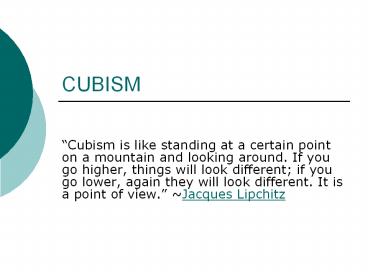CUBISM - PowerPoint PPT Presentation
1 / 21
Title:
CUBISM
Description:
CUBISM Cubism is like standing at a certain point on a mountain and looking around. If you go higher, things will look different; if you go lower, again they will ... – PowerPoint PPT presentation
Number of Views:224
Avg rating:3.0/5.0
Title: CUBISM
1
CUBISM
- Cubism is like standing at a certain point on a
mountain and looking around. If you go higher,
things will look different if you go lower,
again they will look different. It is a point of
view. Jacques Lipchitz
2
Cubism
- A name suggested by Henri Mattisse in 1909
- A non-objective approach to painting
- Pablo Picasso and Georges Braque in 1906
- Pre-Cubist (1906) emphasizing the process of
construction, of creating a pictorial rhythm, and
converting the represented forms into the
essential geometric shapes (cube, sphere,
cylinder, cone) - Analytical Cubism (1909-1911) transpose the
three- dimensional subjects into the flat images
on the surface of the canvas. - Cubist palette was limited to monochromatic scale
colors, dominated by grays and browns. - Synthetic Cubism (1912-1920s) focused on the
construction (new textures and materials) and not
the represented objects in the painting became
more abstract and color expanded to many other
colors
3
Pablo Picasso, Portrait of Wilhelm Uhde, 1910
4
Pablo Picasso, "Three Musician's", 1921
5
Pablo Picasso
6
Popova, Two Figures
7
Juan Gris (1887-1927)Violin and Glass (oil on
canvas, 1915)
8
Students started by drawing a large, fairly
simple image in the center of their paper
9
Then they cut out a simple shape, which may or
may not be somehow related to their chosen
subject, out of cardstock.
10
They traced this shape all over their design in
order to break-up or 'fracture' the image. Below
you can see this student used a skull for her
main subject, and a bone shape to break it up.
11
Then, using colored pencils, students chose their
colors and practiced creating gradations from
light to dark- simply vary the pressure of the
colored pencil.
12
Then start coloring each section- change colors
when you encounter a line.
13
(No Transcript)
14
(No Transcript)
15
(No Transcript)
16
(No Transcript)
17
(No Transcript)
18
(No Transcript)
19
(No Transcript)
20
(No Transcript)
21
(No Transcript)































